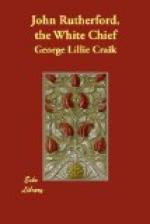One of the arts in which the New Zealanders most excel is that of carving in wood. Some of their performances in this way are, no doubt, grotesque enough; but they often display both a taste and ingenuity which, especially when we consider their miserably imperfect tools, it is impossible to behold without admiration. This is one of the arts which, even in civilized countries, does not seem to flourish best in a highly advanced state of society. Even among ourselves, it certainly is not at present cultivated with so much success as it was a century or two ago.
Machinery, the monopolizing power of our age, is not well fitted to the production of striking effects in this particular branch of the arts. Fine carving is displayed, as in the works of Gibbons, by a rich and natural variety, altogether opposed to that faultless and inflexible regularity of operation which is the perfection of a machine. Hence the lathe, with all the miraculous capabilities it has been made to evolve, can never here come into successful competition with the chisel, in so far as the quality and spirit of the performance are concerned; but the former may, nevertheless, drive the latter out of the market, and seems in a great measure to have done so, by the infinitely superior facility and rapidity of its operation. Hence the gradual decay, and almost extinction among us, of this old art, of which former ages have left us so many beautiful specimens. It is said to survive now, if at all, not among our artists by profession, whose taste is expended upon higher objects, but among the common workmen of our villages, who have pursued it as an amusement, long after it has ceased to be profitable.
The New Zealand artist has no lathe to compete with; but neither has he even those ordinary hand-tools which every civilized country has always afforded. The only instruments he has to cut with are rudely fashioned of stone or bone. Yet even with these, his skill and patient perseverance contrive to grave the wood into any forms which his fancy may suggest. Many of the carvings thus produced are distinguished by both a grace and richness of design that would do no discredit even to European art.
The considerations by which the New Zealanders are directed in choosing the sites of their villages are the same which usually regulate that matter among other savages. The North American Indians, for example, generally build their huts on the sides of some moderately sized hill, that they may have the advantage of the ground in case of being attacked by their enemies, or on the bank of a river, which may, in such an emergency, serve them for a natural moat. A situation in which they are protected by the water on more sides than one is preferred; and, accordingly, both on this account, and for the sake of being near the sea, which supplies them with fish, the New Zealanders and other savage tribes are much accustomed to establish themselves at the mouths of




